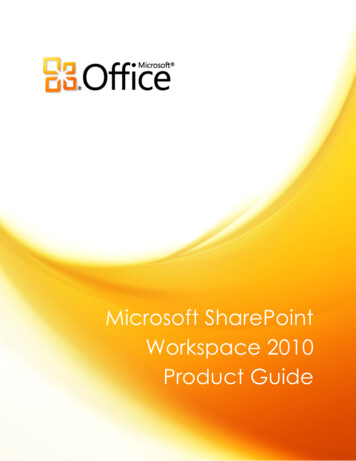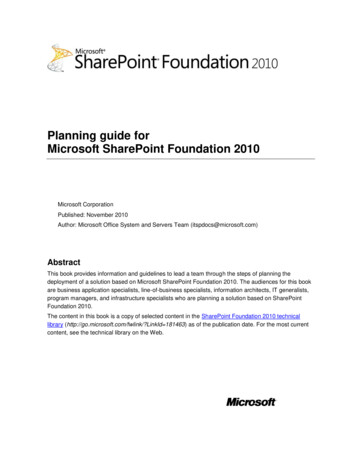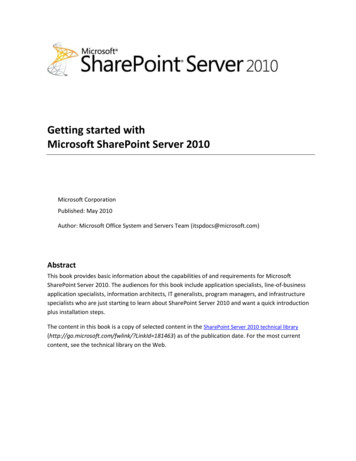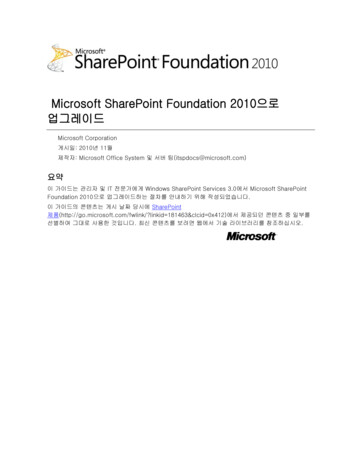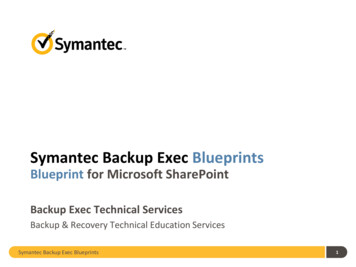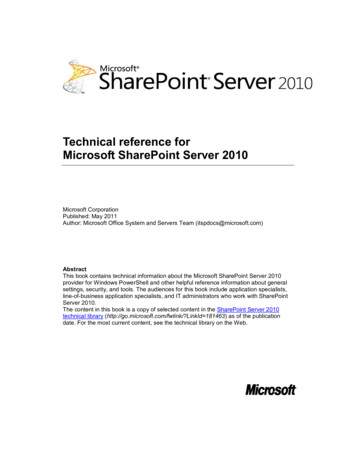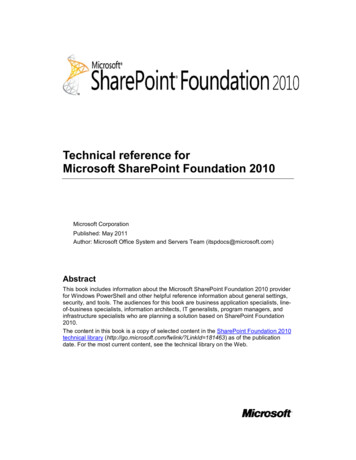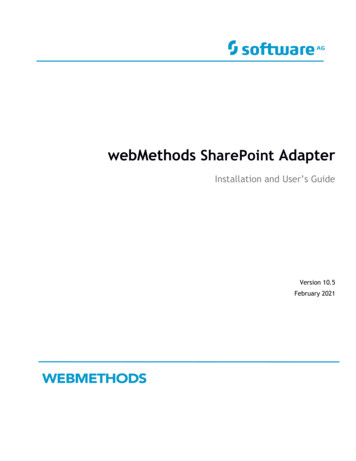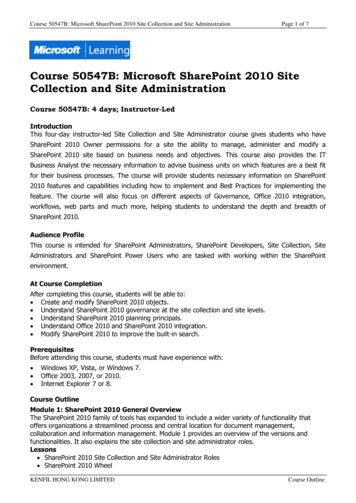
Transcription
Course 50547B: Microsoft SharePoint 2010 Site Collection and Site AdministrationPage 1 of 7Course 50547B: Microsoft SharePoint 2010 SiteCollection and Site AdministrationCourse 50547B: 4 days; Instructor-LedIntroductionThis four-day instructor-led Site Collection and Site Administrator course gives students who haveSharePoint 2010 Owner permissions for a site the ability to manage, administer and modify aSharePoint 2010 site based on business needs and objectives. This course also provides the ITBusiness Analyst the necessary information to advise business units on which features are a best fitfor their business processes. The course will provide students necessary information on SharePoint2010 features and capabilities including how to implement and Best Practices for implementing thefeature. The course will also focus on different aspects of Governance, Office 2010 integration,workflows, web parts and much more, helping students to understand the depth and breadth ofSharePoint 2010.Audience ProfileThis course is intended for SharePoint Administrators, SharePoint Developers, Site Collection, SiteAdministrators and SharePoint Power Users who are tasked with working within the SharePointenvironment.At Course CompletionAfter completing this course, students will be able to: Create and modify SharePoint 2010 objects. Understand SharePoint 2010 governance at the site collection and site levels. Understand SharePoint 2010 planning principals. Understand Office 2010 and SharePoint 2010 integration. Modify SharePoint 2010 to improve the built-in search.PrerequisitesBefore attending this course, students must have experience with: Windows XP, Vista, or Windows 7.Office 2003, 2007, or 2010.Internet Explorer 7 or 8.Course OutlineModule 1: SharePoint 2010 General OverviewThe SharePoint 2010 family of tools has expanded to include a wider variety of functionality thatoffers organizations a streamlined process and central location for document management,collaboration and information management. Module 1 provides an overview of the versions andfunctionalities. It also explains the site collection and site administrator roles.Lessons SharePoint 2010 Site Collection and Site Administrator Roles SharePoint 2010 WheelKENFIL HONG KONG LIMITEDCourse Outline
Course 50547B: Microsoft SharePoint 2010 Site Collection and Site AdministrationPage 2 of 7 Comparing SharePoint 2010 Versions Expanded Browser CapabilitiesAfter completing this module, students will be able to: Understand the role of the SharePoint 2010 Site Collection and Site Administrator. Understand the SharePoint 2010 Wheel. Understand the differences between SharePoint Foundations 2010 and SharePoint 2010. Understand the expanded browser capabilities.Module 2: SharePoint 2010 Environment – Getting StartedThis module will cover basic information for Site Collection and Site Administrators. Having a basicset of terminology and getting the “lay of the land” will help to understand the rest of the course.Lessons SharePoint 2010 Environment Navigation SharePoint 2010 Ribbon Adding and Editing Content in SharePoint 2010 Using Your Name MenuAfter completing this module, students will be able to: Understand SharePoint 2010 Terminology and the Environment. Navigate around SharePoint 2010. Be able to use the SharePoint 2010 Ribbon. Be able to add and edit basic content within SharePoint 2010. Use the Your Name Menu.Module 3: Organization and Development of SharePoint 2010 SitesFor organizations that are implementing or continuing to improve SharePoint 2010, the majority ofthe work is not found in the day-to-day activities of creating and managing SharePoint 2010 objects.It falls within the realm of governance and establishing best practices for how SharePoint 2010 isused within the organization. Without establishing these principals within the organization,SharePoint 2010 will fail.Lessons Governance and Best Practices Information Architecture Site Structure User Education ResourcesAfter completing this module, students will be able to: Understand Governance and Best Practices within SharePoint 2010. Understand Information Architecture. Understand how site structure can help within SharePoint 2010. Understand how user education can help with SharePoint 2010.Module 4: Site Collections, Top Level Sites and SitesThe first major milestone after Governance is the creation of sites within a site collection.Understanding the types of sites available within SharePoint 2010, as well as the process of creatingand understanding navigation, is the foundation for site collection and site managers.Lessons Overview of SharePoint 2010 Hierarchy SharePoint 2010 Site Inventory Creating Sites and Subsites Modifying Site Navigation Specialty Sites Sites and Navigation Best PracticesLab : Site Collections, Top Level Sites and SitesKENFIL HONG KONG LIMITEDCourse Outline
Course 50547B: Microsoft SharePoint 2010 Site Collection and Site AdministrationPage 3 of 7 Exercise 1: Create a New Top Level Site Exercise 2: Create New Sub-Sites called New and Current Projects and Sales Exercise 3: Configure Navigation between the Learning Lake Site Exercise 4: Create a Records Center Exercise 5: Create a Projects Web Database site for Sales Exercise 6: Create and Configure a Visio Process Repository Exercise 7: Create a Document WorkspaceAfter completing this module, students will be able to: Understand the different types of SharePoint 2010 sites available. Know how to create SharePoint 2010 sites. Know how to modify site navigation.Module 5: Creating and Modifying Libraries and ListsMost of the administrating within SharePoint 2010 is done at the list or library level. This module willdig deeper into both lists and libraries and will help organizations determine what works best for agiven situation.Lessons Overview of Libraries Creating a Library in SharePoint 2010 Library Inventory Overview of Lists Creating a List in SharePoint 2010 List Inventory Library and List Best PracticesLab : Creating and Modifying Libraries and Lists Exercise 1: Create a Custom List Exercise 2: Create a New Product Survey Exercise 3: Create a List from Excel Exercise 4: Create a Document Library Exercise 5: Create an Asset Library Exercise 6: Create a Wiki Page LibraryAfter completing this module, students will be able to: Understand the purpose of lists and libraries. Understand the differences between the different lists and libraries. Create a list or library using multiple methods. Customize a list form using InfoPath 2010.Module 6: Managing Permissions for Users and GroupsThis module will explain how permissions work within a site collection and the tools within SharePoint2010 that are used to manage and maintain them. Being able to create and manage permissionswithin SharePoint 2010 is one of the more crucial elements that SharePoint 2010 Site Collection andSite Administrators need to know.Lessons Overview of Permissions and Security in SharePoint 2010 Permissions within SharePoint 2010 Managing Permissions within SharePoint 2010 Stop Inheriting Permissions Creating a New SharePoint 2010 Group Managing Users and Groups Other Permissions Management Tools Permissions Best PracticesLab : Managing Permissions for Users and Groups Exercise 1: View Permissions of SharePoint 2010 Objects Exercise 2: Add Users and Groups to SharePoint 2010 ObjectsKENFIL HONG KONG LIMITEDCourse Outline
Course 50547B: Microsoft SharePoint 2010 Site Collection and Site AdministrationPage 4 of 7 Exercise 3: Create a New Managers Group with Customized Permissions Exercise 4: Stop Inheriting Permissions between SharePoint 2010 ObjectsAfter completing this module, students will be able to: Understand how permissions work within SharePoint 2010. Manage permissions within the site collection and site. Understand the tools for permissions within SharePoint 2010.Module 7: Site/Content Management and CollaborationWhen a new site is created, the site administrators will need to decide how content is managedwithin the site. They will also need to consider how sites flow between each other, how informationis portrayed, especially at the Welcome Page level, and how content is managed within the site.Lessons Overview of Site and Content Management Content Management Records Management with the Records Center Setting up Alerts and Real Simple Syndication Targeting Audiences with Content Site and Content Management Best PracticesLab : Site and Content Management Exercise 1: Modify the Current Welcome Page Exercise 2: Enable Content Management Exercise 3: Enable Content Rating Exercise 4: Working with Records Center Exercise 5: Enabling and Configuring Audience TargetingAfter completing this module, students will be able to: Understand the concept of Site and Content Management. Implement aspects of Site and Content Management. Understand and implement Records Management through Records Center. Setup Alerts and Real Simple Syndication feeds. Implement Targeting Information for Users.Module 8: Office 2010 Integration with SharePoint 2010The heavy integration of Microsoft Office 2010 is one of the main benefits of using SharePoint 2010.There are a myriad of ways to connect SharePoint 2010 to Microsoft Office 2010, whether it isconnecting a SharePoint 2010 document library to Microsoft Outlook, linking an Access database oran Excel spreadsheet to a list in SharePoint 2010, using Microsoft InfoPath to build SharePoint 2010lists, publishing a Visio diagram to be displayed in the web, or managing Microsoft PowerPoint slidesin a SharePoint 2010 slide library.Since a majority of SharePoint 2010 users work out of Outlook most of the day, this integration withSharePoint 2010 helps to focus activities in one or two locations instead of four or five locations. Allof these options provide significant improvements over using the products on their own. This modulewill cover the different ways in which SharePoint 2010 and the Office 2010 Suite work together toexpose the full functionality of the products.Lessons Overview of Office 2010 and Office Web App Collaborating Using Outlook 2010 Connecting and Collaborating with Office 2010 Backstage Connecting, Managing and Editing Documents Collaborating with PowerPoint 2010 Take Information Offline with SharePoint Workspace 2010 Integration of Visio 2010 Integration of Access 2010 Using InfoPath 2010 with SharePoint 2010KENFIL HONG KONG LIMITEDCourse Outline
Course 50547B: Microsoft SharePoint 2010 Site Collection and Site AdministrationPage 5 of 7 Office 2010 Integration Best PracticesLab : Office 2010 Integration with SharePoint 2010 Exercise 1: Connect Outlook 2010 with SharePoint 2010 Exercise 2: Collaborate with PowerPoint 2010 Exercise 3: Connect Visio 2010 to Visio Process Repository Exercise 4: Working with Information Offline with Workspace 2010After completing this module, students will be able to: Understand the integration features between Office 2010 and SharePoint 2010. Understand how Office Web Apps works between the two products. Understand the collaboration features available with Outlook 2010. Understand how Excel and Word interact with SharePoint 2010. Understand how PowerPoint can expand collaboration and presentations. Understand how SharePoint 2010 can be taken offline with Workspace 2010. Understand the integration of Visio and Access with SharePoint 2010. Have a basic understanding of how InfoPath 2010 works with SharePoint 2010.Module 9: Creating Consistency Across SitesWhen developing SharePoint 2010, it is necessary to create a consistent feel across sites within thesite collection. This objective fits in to the Governance aspects of Module 3: Organization andDevelopment of SharePoint 2010 Sites.Lessons Site Columns Site Content Types Implementing Document Sets Show/Hide the Server Ribbon SharePoint Site Themes Overview of SharePoint Templates Managing Through Site Templates Managing Through List and Library Templates Page Layout and Site Template Settings Consistency Best PracticesLab : Creating Consistency Across Sites Exercise 1: Modify the SharePoint 2010 Site Theme Exercise 2: Create a Site Content Type Exercise 3: Create Document Set for Learning Lake Exercise 4: Create a Site Template Exercise 5: Create a List and Libraries Template Exercise 6: Designate a Specific Page Layout and Site TemplatesAfter completing this module, students will be able to: Understand and use Site Content Types and Columns. Understand and Implement Document Sets. Implement and Customize SharePoint Site Themes.Module 10: Finding Information Using Search and ViewsOne common complaint within organizations is the difficulty finding documents in a timely manner.Many hours are wasted searching for a specific document. This module will show methods forsearching and configuring views in order to assist SharePoint 2010 users in finding what they need inmuch less time.Lessons Overview of Views Adding Columns to Lists and Libraries Creating Views in Lists and Libraries Configuring Per-Location ViewKENFIL HONG KONG LIMITEDCourse Outline
Course 50547B: Microsoft SharePoint 2010 Site Collection and Site AdministrationPage 6 of 7Overview of Metadata and Taxonomy for SharePoint 2010Implementing Managed MetadataOverview of SearchImplementing Managed Keywords and Best BetsUsing SharePoint SearchConfiguring Search ScopeConfiguring Search VisibilityView and Search Best PracticesLab : Finding Information Using Search and Views Exercise 1: Use Sorting and Grouping to Modify a View Exercise 2: Create a New View for Project Documents Exercise 3: Create Calendar and Gantt Chart Views Exercise 4: Create and Implement Managed Keywords and Best Bets Exercise 5: Optimize Project Documents for Search Exercise 6: Test Search to Find InformationAfter completing this module, students will be able to: Understand and configure multiple types of Views. Understand and configure Per-location Views. Understand and implement Metadata within SharePoint 2010. See how Search and Faceted Search work. Configure Search Scopes and Visibility within SharePoint 2010. Module 11: Displaying Data with Web Parts in SharePoint 2010Displaying Data with Web Parts in SharePoint 2010One important feature within SharePoint 2010 is the many different Web Parts. Most of theSharePoint 2010 Web Parts can be customized. This module will cover the different types of WebParts that are available and the process of embedding and configuring them.Lessons Overview of Web Parts Web Part Inventory Managing a Web Part on a Page Managing a Web Part Customizing a Web Part Web Part Maintenance Web Parts Best PracticesLab : Displaying Data with Web Parts in SharePoint 2010 Exercise 1: Create and Modify a Web Part Page Exercise 2: Implement and Configure a Link List Web Part Exercise 3: Direct Tasks to Individuals using Task List Web Part Exercise 4: Implement and Configure a List View Web Part Exercise 5: Connect Web Parts to Display Information Exercise 6: Use a Content Query Web Part Exercise 7: Display Visio Diagrams using Visio Web Access Exercise 8: Use a Chart Web Part to Display DataAfter completing this module, students will be able to: Understand the different types of Web Parts. Understand how to display Web Parts within a SharePoint 2010 page. Understand basic properties used to configure Web Parts. Understand how to maintain Web Parts.Module 12: Document Management through WorkflowsAn integral part of SharePoint 2010 for document and information management is the ability toconfigure Workflows. By default, SharePoint 2010 comes with built-in Workflows to helpKENFIL HONG KONG LIMITEDCourse Outline
Course 50547B: Microsoft SharePoint 2010 Site Collection and Site AdministrationPage 7 of 7organizations in a variety of different ways, including; approving a new item or document, collectingfeedback from multiple users, or disposing of documents based on compliance policies.Lessons Overview of SharePoint 2010 Workflows Approval - SharePoint 2010 Workflow Three-State Workflow Collect Feedback - SharePoint 2010 Workflow Collect Signatures - SharePoint 2010 Workflow Disposition Workflow Managing Workflows in SharePoint 2010Lab : Document Management through SharePoint 2010 Workflows Exercise 1: Create a Workflow to Approve New Projects Exercise 2: Create a Feedback Workflow Exercise 3: Create a Disposition Approval WorkflowAfter completing this module, students will be able to: Understand Workflows within SharePoint 2010. Implement and Configure the Approval – SharePoint 2010 Workflow. Implement and Configure the Three-State Workflow. Implement and Configure the Collect Feedback – SharePoint 2010 Workflow. Implement and Configure the Collect Signatures – SharePoint 2010 Workflow. Implement and Configure the Disposition Workflow. Understand how to Manage Workflows after created.Module 13: SharePoint 2010 Social Computing and CollaborationAn important advancement within SharePoint 2010 is the inclusion of Social Computing concepts.Many organizations have similar challenges when working with internal talent management, alsoknown as knowledge management. One common challenge is finding an individual with the specificskills and knowledge needed to complete a task or project. SharePoint 2010 offers a viable platformto help organizations with talent or knowledge management.Lessons Overview of Social Computing Using My Sites for Knowledge Management Configuring My Profile Using Social Tags and Note Boards SharePoint 2010 My Site Blog SharePoint 2010 Social Computing Best PracticesAfter completing this module, students will be able to: Understand the different components of SharePoint 2010 My Sites. Understand how to configure SharePoint 2010 My Profile. Understand how Social Tags and Note Boards are integrated into SharePoint 2010. Understand how to implement and configure My Site Blogs.Module 14: Administrating a SharePoint 2010 Site Collection and SiteThis module covers SharePoint 2010 topics that Site Collection or Site administrators will work withas part of their day to day activities.Lessons Overview of Administrating of SharePoint 2010 Additional Settings for Site Administration Additional Settings for Site Collection AdministrationAfter completing this module, students will be able to: Understand Governance for Site Administration. Understand additional settings available for Site Administrators. Understand additional settings available for Site Collection Administrators.KENFIL HONG KONG LIMITEDCourse Outline
feature. The course will also focus on different aspects of Governance, Office 2010 integration, workflows, web parts and much more, helping students to understand the depth and breadth of SharePoint 2010. Audience Profile This course is intended for SharePoint Administrators, SharePoint Developers, Site Collection, Site

